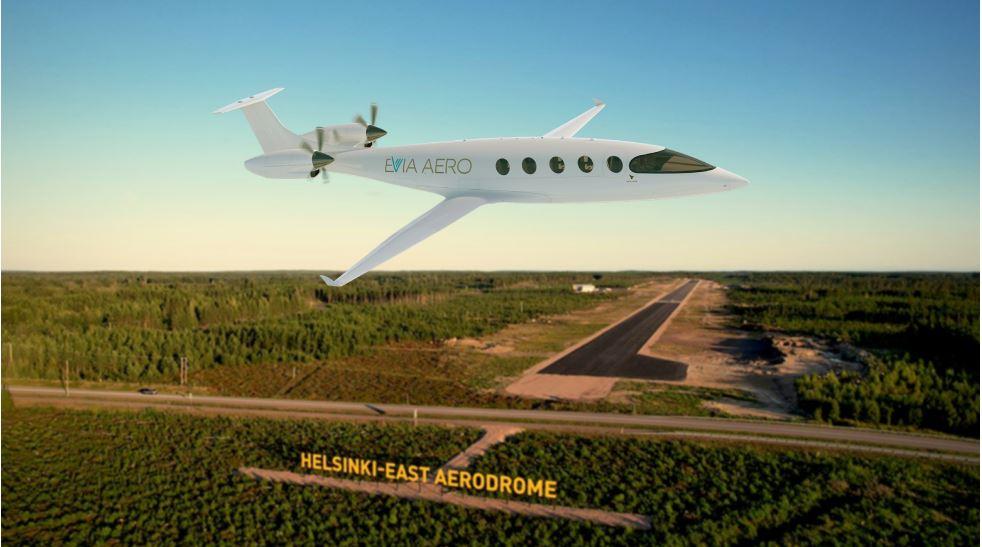
Evia Aero has ordered electric and hydrogen-electric aircraft from startups Eviation and Cranfield Aerospace, respectively.
German startup Evia Aero has announced plans to develop a 50-megawatt photovoltaic plant at Helsinki-East Aerodrome, part of a larger vision to build out a complete value chain for sustainable aviation as an operator and infrastructure provider.
The photovoltaic plant (PV) will be built jointly in partnership with Finnish airport developer Redstone Aero, and is expected to be operational within 24 months after receipt of the building permit and construction of the grid connection, the companies say. In addition to electric charging stations, the partners will build out buffer batteries for intermediate storage and small electrolyzers to refuel hydrogen-electric aircraft.
The PV plant at Helsinki Aerodrome will eventually be joined by other similar facilities at airports where Evia Aero plans to operate its sustainable airline in Europe, with other projects to be announced in the coming weeks and months, CEO Florian Kruse tells the AAM Report.
The green electricity and hydrogen will be needed to power Evia’s future fleet of sustainable regional airliners. The company has so far placed orders for up to 25 nine-seat Alice electric airplanes from Washington-based startup Eviation and 10 hydrogen-powered Britten-Normen Islanders from U.K. startup Cranfield Aerospace Solutions, as well as five conversion kits.
“With these PV plants, we can produce power for ourselves and keep it in battery storage for the [Eviation] Alice aircraft, or we can convert it with small electrolyzers to hydrogen and make sure that we can charge or refuel our Islanders with 100% sustainable hydrogen,” Kruse says.
The charging and energy storage systems can also be used by other operators for a fee, Kruse adds.
“This investment is an ecosystem; we’re not the only company who can charge and use this equipment,” he says. “If flight schools want to charge their Pipistrel aircraft, or even other competitors, it doesn’t matter to us ... we’re open for everyone, and we can get extra revenue this way too.”
Evia Aero has obtained a European air operator’s certificate with which it plans to launch its regional airline. The first deliveries of modified Islanders are expected in 2026, while Eviation is targeting EASA certification in 2029. The startup hopes to launch service as soon as possible, although Kruse acknowledges risk to its timeline.
“We are not naive. We know both technologies are new and the aircraft do not have certification yet,” he says. “Delays can happen, and that’s not in our control. But we don’t really see a problem, because we will still operate our PV systems, and we can generate revenues that way until the aircraft arrive.”
Kruse says he sees different strengths and use cases for the all-electric Alice and hydrogen-electric Islanders within Evia’s future European network. “The Islanders will get just 200 km (124 mi.) range, but at a lower cost because it’s a conversion aircraft, and we can get it a bit sooner, in 2026, which is excellent,” he says. “We see it as the perfect airline to go on short island hops, over shorelines or nearby.
“The Alice aircraft is a pure commuter, and far from our point of view, a corporate-focused aircraft,” he adds. “It is wonderfully designed, with no noise because of the electric motors. With improving battery technology every few years, we will get more and more range from them, which is very important for us.”
By laying the groundwork for sustainable regional aviation, Kruse says that Evia Aero is working toward a goal of revitalizing regional air travel across Europe, a market that has shrunk markedly in recent years due to unfavorable operating economics and political pressure related to decarbonization.
“It made no sense in the past to fly these smaller aircraft on regional services, but this new technology changes all that,” he says. “This is possible because we will have up to 60% less maintenance costs with electric motors, and on the other hand, we don’t have to hedge fuel because we produce our own power. That’s the business model, the full value chain of sustainable aviation.”





